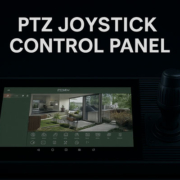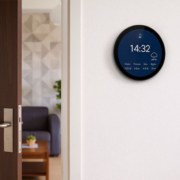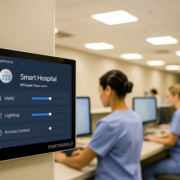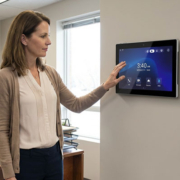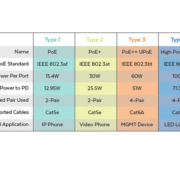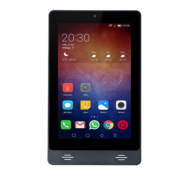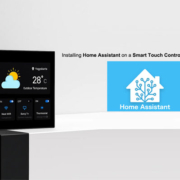Making the Smart Display Your Central Family & Automation Hub
In today’s fast-paced, connected world, the concept of home automation has gone beyond just controlling lights or adjusting the thermostat. Families are now seeking ways to create a unified, user-friendly control center for all their smart devices and daily routines. A smart display can serve as the heart of this transformation, becoming your family’s central hub for communication, entertainment, security, and home automation. Here’s how you can turn a smart display into your go-to tool for managing and simplifying daily life.
What Is a Smart Display?
A smart display is essentially a combination of a digital screen and a smart assistant, designed to integrate with various devices and services in your home. It typically features a high-resolution touchscreen interface, built-in voice control (such as Amazon Alexa, Google Assistant, or other platforms), and the ability to manage a wide range of smart home technologies.
The beauty of a smart display lies in its versatility: it can function as a digital photo frame, a weather update hub, a music player, a video call device, and, most importantly, a central command center for all your smart home devices.
Key Features of Smart Displays as Family & Automation Hubs
-
Centralized Control for Smart Devices
The biggest advantage of using a smart display as your home hub is its ability to control virtually all smart devices in your home from one location. With the integration of technologies such as Zigbee, Z-Wave, and Matter, smart displays can connect to a wide range of devices, including lights, thermostats, security cameras, door locks, and even kitchen appliances. You can control these devices by either touching the display screen or simply issuing voice commands, making it the most convenient way to manage your smart home. -
Family Communication Made Easy
Communication within the family is made simpler with a smart display. Whether it’s sending a message to a family member, making a video call, or showing the family calendar, the smart display keeps everyone connected. Features like video calling (using services like Skype or Zoom), shared calendars, and reminders ensure that family members stay in sync, no matter where they are in the house. -
Enhanced Home Security
Security is a major concern for most households, and a smart display can significantly contribute to the safety of your home. By integrating your home security cameras with your smart display, you can easily check who’s at the door, monitor areas around your house, or even receive real-time alerts when motion is detected. Many smart displays come with built-in motion sensors and can be paired with other smart home security systems for a comprehensive solution.
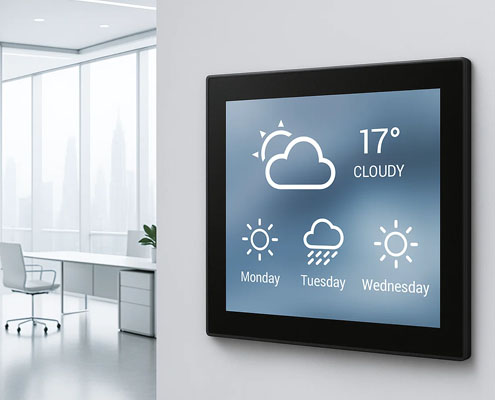
smart control panel
-
Entertainment Hub for the Family
A smart display can be the ultimate entertainment center for the entire family. Whether it’s streaming your favorite shows, listening to music, or watching YouTube videos, everything can be managed on one device. The large, high-resolution touchscreen is perfect for watching video content, and the sound quality is often superior to smaller devices like smartphones or tablets. Music streaming services like Spotify or Apple Music can also be controlled directly through the display, creating a personalized entertainment hub. -
Voice and Touch Controls for Ease of Use
For families with young children or elderly members, a smart display offers the convenience of both voice and touch control. Children can ask questions, play their favorite songs, or even ask for the weather forecast, while elderly family members can control devices without needing to fumble with tiny buttons or apps on their phones. The smart display can be the perfect device for all ages, offering an easy, intuitive interface for everyone in the family. -
Automated Routines for Everyday Tasks
One of the most powerful features of a smart display is its ability to help you automate routine tasks. With the use of smart home platforms such as Google Home or Alexa, you can create automation rules that trigger certain actions at specific times. For example, you can set up an automation to turn on the lights when you say, “Good morning,” or have the coffee maker start brewing when your display detects you’re awake. This creates a more efficient and convenient daily routine, saving time and effort. -
Integration with Home Assistants for More Control
A smart display can seamlessly integrate with various voice assistants like Amazon Alexa or Google Assistant. This means you can control your entire home with simple voice commands. For example, you can say, “Set the living room lights to 50% brightness,” or “Lock the front door,” and the smart display will execute the command in real-time. Integration with smart home ecosystems ensures that all your devices are working in harmony and that you’re in complete control.
Turning Your Smart Display into the Family’s Digital Command Center
To truly make the most of your smart display, it’s important to customize it to fit your family’s unique needs. Here are a few steps to get started:
-
Set Up Shared Calendars and To-Do Lists
Add shared family calendars to your smart display so that everyone can see important dates, appointments, and events. Sync to-do lists for tasks that need to be done, such as grocery shopping or cleaning, to keep everyone on the same page. These features help ensure that the family stays organized and that nothing important slips through the cracks. -
Create Personalized Routines
Set up routines for your family members based on time of day or activities. For example, create a “Good Morning” routine that automatically adjusts the thermostat, turns on the lights, and plays music when you wake up. Or set a “Movie Night” routine to dim the lights and open the blinds. These personalized routines help create a seamless experience and make your home more efficient. -
Secure Your Display with Family-Friendly Settings
Many smart displays come with parental controls to restrict access to certain apps or settings. This is particularly useful for families with younger children. You can set up child-friendly modes that limit access to age-appropriate content and keep any sensitive data secure. -
Connect All Your Smart Devices
Ensure that all your smart devices are compatible with the smart display. This includes things like lighting, thermostats, cameras, smart locks, and kitchen appliances. Once connected, you’ll have full control over all your devices, whether through touch or voice commands.
A Smart Display for Smarter Living
By making the smart display the central hub of your family’s daily routine, you’re creating a streamlined, efficient, and fun home environment. With easy control over smart devices, instant communication, entertainment at your fingertips, and robust security features, your family’s smart display can truly become the heart of your home. As smart home technology continues to evolve, the role of the smart display will only become more integral to a fully automated and connected living space.


